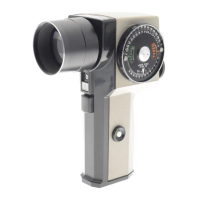
Do you have a question about the Pentax SPOTMETER V and is the answer not in the manual?
| Brand | Pentax |
|---|---|
| Model | SPOTMETER V |
| Type | Spot Meter |
| Metering Modes | Spot |
| Angle of Acceptance | 1 degree |
| Shutter Speed Range | 1/4000 sec. to 4 min. |
Defines the operational EV range from 1 to 19.
Specifies the supported film speed settings from ASA 6 to 6400.
Details diaphragm from f/1 to f/128 and shutter speeds from 1/4000s to 4 mins.
Measures a 1° angle of arc in the center of the finder.
Operational range from 1.5 meters to infinity.
Utilizes spot metering of reflected light.
Features SPD photo cell and three G-13 mercury batteries.
Pentaprism viewfinder providing unreversed, right-side-up image.
Provides width, height, length, and weight of the device.
Lists mercury batteries, wrist strap, and case.
Enables precise exposure measurement from the camera's position.
Measures light with a precise 1° angle of arc for accuracy.
Features 1.5x magnification, unreversed, right-side-up image.
Allows measuring exposure through filters to adjust for color.
Usable for television broadcasting to adjust lighting and contrast ratios.
Step-by-step guide for inserting three G-13 mercury batteries correctly.
Details long battery life and sudden power loss warning.
Explains how to use the 'B' button to check battery condition.
Instructions for setting film speed using the ASA/DIN disk.
How to adjust the eyepiece for a clear view of the light level scale.
Procedure for aiming, metering, and reading the light level scale.
Enables reading in low light conditions.
Aligning EV readings with the calculator dial.
Choosing shutter speed and aperture combinations from calculator scales.
Understanding exposure combinations and selecting usable settings for the camera.
Advises taking several readings from different subject areas.
Explains IRE units for light energy comparison, used in TV and photography.
Details black level (Index 1), intermediate brightness (Indices 2-9), and white level (Index 10).
Explains the standard index (18% reflectance) and contrast ratio (1:32).
Measures an area of average tonal quality for exposure setting.
Calculates average exposure from highlight and shadow readings.
Sets exposure based on the subject's highlight light levels.
Using highlight metering for low-key effects like nocturnal scenes.
Sets exposure based on shadow areas, useful for backlighting and night scenes.
Table converting Exposure Values (EV) to candelas per square meter and foot lamberts.
How to adjust the indicator needle to the zero position.
Tips for metering very small points or close subjects.
Using filters with the spotmeter to improve B&W contrast of colored objects.
Considering color distribution for attractive TV broadcasts.
Details the use of the spotmeter for feature films and documentaries.
Adapting shutter speed and aperture settings for 35mm, 16mm, and 8mm movie cameras.
Guide to adjusting the wrist strap for optimal fit.
Details the threaded connection for tripod mounting.
Explains viewfinder readings directly in foot lamberts for T.V. and film making.
Describes how to set and read luminance ratios using the calculator dial.